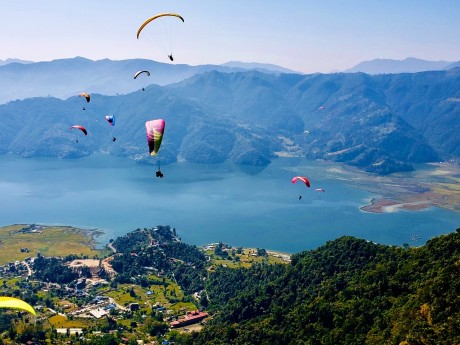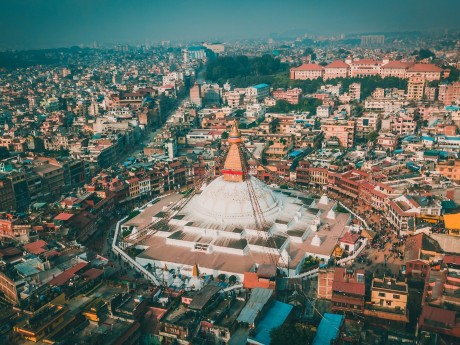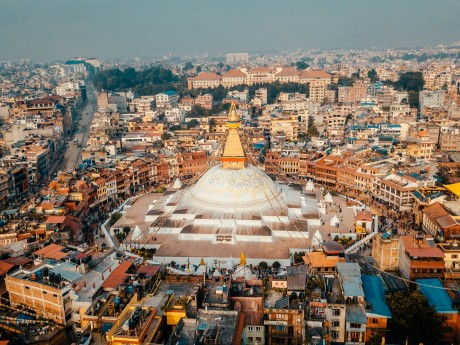Nepal: Kathmandu & Pokhara
Embark on a journey to Kathmandu and Pokhara for an unforgettable adventure through Nepal's rich cultural heritage and breathtaking natural beauty. In Kathmandu, immerse yourself in the vibrant tapestry of ancient temples, bustling markets, and sacred sites. Explore Durbar Square and marvel at the intricate architecture of centuries-old temples and palaces. The spiritual ambiance of Swayambhunath Temple offers a moment of tranquility amidst the bustling city.
Read more
Embark on a journey to Kathmandu and Pokhara for an unforgettable adventure through Nepal's rich cultural heritage and breathtaking natural beauty. In Kathmandu, immerse yourself in the vibrant tapestry of ancient temples, bustling markets, and sacred sites. Explore Durbar Square and marvel at the intricate architecture of centuries-old temples and palaces. The spiritual ambiance of Swayambhunath Temple offers a moment of tranquility amidst the bustling city. After the cultural immersion in Kathmandu, continue to Pokhara, a serene oasis nestled at the foot of the towering Himalayas. Take a boat ride across the tranquil waters of Phewa Lake, to the iconic World Peace Pagoda, where panoramic views of the surrounding mountains inspire a sense of awe and serenity. Visit Devi’s Falls and Gupteshwor Cave, where cascading waterfalls vanish into hidden caverns, creating an enchanting atmosphere. Whether exploring ancient temples in Kathmandu or marvelling at mountain vistas in Pokhara, every moment of the trip is infused with a sense of wonder and adventure. Waterviews strives to offer accommodation options within walking distance of water and/or in an area of touristic interest. Our prices include taxes (but excludes local tourist taxes). Customize your trip to your personal preferences with optional activities (hit the “Add Activities’’) or change hotels, etc. Contact us for customization at no extra cost at: Service@waterviewstravel.com
Destinations
- Pokhara
- Kathmandu
Itinerary
Pokhara

Lakeside Pokhara is one of Nepal’s finest tourist destinations, serving as the starting point for explorations of the country’s spectacular nature. Pokhara’s tranquil beauty, pristine air and incredible mountainous backdrop instantly charms, and whether you’re looking for adventure or relaxation you’ll find it here. From paragliding and white-water rafting to trekking and kayaking, the activities here are endless, and the city itself offers an excellent range of accommodation options, eateries and shops to suit all tastes and budgets.
Read more
Lakeside Pokhara is one of Nepal’s finest tourist destinations, serving as the starting point for explorations of the country’s spectacular nature. Pokhara’s tranquil beauty, pristine air and incredible mountainous backdrop instantly charms, and whether you’re looking for adventure or relaxation you’ll find it here. From paragliding and white-water rafting to trekking and kayaking, the activities here are endless, and the city itself offers an excellent range of accommodation options, eateries and shops to suit all tastes and budgets.
Kathmandu

Backed by the snow-capped peaks of the Himalayas, Nepal’s capital and largest city, Kathmandu, is a fast-growing destination that caters to a wide range of holiday types and budgets. The city’s old town centres around bustling Durbar Square, where you’ll find a host of historic buildings, and leads to maze-like alleys that are home to local markets, shops and hidden temples. Intoxicating, evocative and vibrant, Kathmandu is the gateway to the cultural, historical and natural jewels of Nepal.
Read more
Backed by the snow-capped peaks of the Himalayas, Nepal’s capital and largest city, Kathmandu, is a fast-growing destination that caters to a wide range of holiday types and budgets. The city’s old town centres around bustling Durbar Square, where you’ll find a host of historic buildings, and leads to maze-like alleys that are home to local markets, shops and hidden temples. Intoxicating, evocative and vibrant, Kathmandu is the gateway to the cultural, historical and natural jewels of Nepal.
Additional Information
According to a census conducted in 2011, Kathmandu metropolis has 2.5 million inhabitants, and the agglomeration has a population of more than 3 million inhabitants. The metropolitan city area is 50.67 km² (19.56 sq mi) and has a population density of 3000 per km² and 17,000 per km square in the city proper.
The city stands at an elevation of approximately 1,400 metres (4,600 ft) in the bowl-shaped Kathmandu Valley of central Nepal. It is surrounded by four major mountains: Shivapuri, Phulchoki, Nagarjun, and Chandragiri. Kathmandu Valley is part of three districts (Kathmandu, Lalitpur, and Bhaktapur), has the highest population density in the country, and is home to about a twelfth of Nepal's population.
Historically, the Kathmandu Valley and adjoining areas were known as Nepal Mandala. Until the 15th century, Bhaktapur was its capital when two other capitals, Kathmandu and Lalitpur, were established. During the Rana and Shah eras, British historians called the valley "Nepal Proper". Today, Kathmandu is the capital of the Federal Democratic Republic of Nepal, and also the headquarters of the Central Development Region of Nepal. The Central Region comprises three zones: Bagmati, Narayani, and Janakpur. Kathmandu is located in the Bagmati Zone.
Kathmandu is the gateway to tourism in Nepal. It is also the nerve center of the country's economy. It has the most advanced infrastructure of any urban area in Nepal, and its economy is focused on tourism, which accounted for 3.8% of Nepal's GDP in 1995–96. Tourism in Kathmandu declined thereafter during a period of political unrest, but since then has improved. In 2013, Kathmandu was ranked third among the top 10 travel destinations on the rise in the world by TripAdvisor,and ranked first in Asia.
The city has a rich history, spanning nearly 2000 years, as inferred from inscriptions found in the valley. Religious and cultural festivities form a major part of the lives of people residing in Kathmandu. Most of Kathmandu's people follow Hinduism and many others follow Buddhism. There are people of other religious beliefs as well, giving Kathmandu a cosmopolitan culture. Nepali is the most commonly spoken language in the city. English is understood by Kathmandu's educated residents.
Kathmandu's sister cities (Lalitpur Patan) and Bhaktapur are integral to Kathmandu's cultural heritage, tourism industry, and economy; therefore UNESCO's World Heritage Site lists all three cities' monuments and attractions together under one heading, "Kathmandu Valley-UNESCO World Heritage Site".
Climate
Kathmandu Valley is in the Warm Temperate Zone of Nepal (elevation ranging from 1,200–2,300 metres (3,900–7,500 ft)), where the climate is fairly temperate, atypical for the region. This zone is followed by the Cool Temperate Zone with elevation varying between 2,100–3,300 metres (6,900–10,800 ft). Portions of the city with lower elevations have a humid subtropical climate, while portions of the city with higher elevations generally have a subtropical highland climate. In the Kathmandu Valley the average summer temperature varies from 28–30 °C (82–86 °F). The average winter temperature is 10.1 °C (50.2 °F).
The city generally has a climate with warm days followed by cool nights and mornings. Unpredictable weather is expected given temperatures can drop to 3 °C (37 °F) during the winter. During a 2013 cold front, the winter temperatures of Kathmandu dropped to −4 °C (25 °F), and the coldest temperature was recorded in January 10, 2013 at −9.2 °C (15.4 °F). Rainfall is mostly monsoon-based (about 65% of the total concentrated during the monsoon months of June to August), and decreases substantially (100 to 200 cm (39 to 79 in)) from eastern Nepal to western Nepal. Rainfall has been recorded at about 1,400 millimetres (55.1 in) for the Kathmandu valley, and averages 1,407 millimetres (55.4 in) for the city of Kathmandu. On average humidity is 75%.
Tourist information
© Sourced from Wikivoyage





